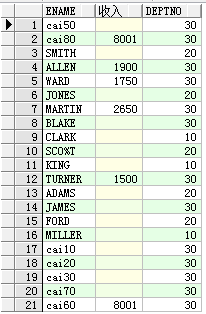一,select
select 用于从数据看查询数据。语法:
select field1,filed2,.. . from tablename [where condition]
举例:
-- 查询所有员工的名字和雇员号 select e.ename,e.empno from emp e;
* 通配符表示查询所有字段。如果要查特定字段时,不要使用*,影响查询效率
select * from emp;
distinct(修饰多字段时,多个字段的值都不一样才保留)
-- 查询公司的工种 select distinct e.job from emp e;
where字句
where 表示查询的条件。
[1] =,!= ,<>,<,>,<=,>= 关系运算符
<> 表示不等于
-- 把部分10的雇员查询出来 select * from emp where deptno = 10; -- 把名称为smith的雇员 select e.* from emp e where e.ename = 'SMITH'; -- 查询底薪大于等于1000的员工 select e.* from emp e where e.sal >= 1000; select e.* from emp e where e.sal <> 800
any/some/all (list)
any/some(list) 满足list列表中的任意一个条件
all(list) 满足list列表的中所有条件
-- 查询薪资大于1000或者薪资大于800的雇员 select e.* from emp e where e.sal > some(1000,800); -- 查询薪资大于1000 select e.* from emp e where e.sal > all(1000,800);
[2] null
null 在sql中表示的是不确定 => 可以认为没有值
-- 查询没有津贴的雇员 select e.* from emp e where e.comm is null select e.* from emp e where e.comm is not null
[3] between x and y
表示一个值位于[x,y]区间,x/y 一般都是数字
-- 查询薪资在1000-5000之间的雇员 select e.* from emp e where e.sal between 1000 and 5000 -- 查询薪资在(3000,5000]之间的雇员 select e.* from emp e where e.sal between 3000.01 and 5000
[4] in/not in list
表示字段值是否在list列表中
-- 查询部分号是10和20的员工 select e.* from emp e where e.deptno in(10,20); select e.* from emp e where e.deptno not in(10,20); -- 查询薪资是1000,2000,5000的员工 select e.* from emp e where e.sal in (1000,2000,5000);
[5] 模糊查询
like 关键字用于模糊查询,其中
%:表示任意字符出现多次(含0次),
_:表示任意字符出现1次。
escape(‘x’) 表示指定转义字符为x,一般指定为
-- 查询名字是c开头的雇员 select e.* from emp e where e.ename like 'c%'; -- 查询名字中第二个字母是M的雇员 select e.* from emp e where e.ename like '_M%' -- 查询名字中含有M的雇员 select e.* from emp e where e.ename like '%M%'; -- 查询名字中含有%的雇员 select e.* from emp e where e.ename like '%\%%' escape('');
二,复杂查询
where 后面的条件可以跟多个通过and 或者 or 连接
and:且、并且
or: 或、或者
-- 查询部门10且薪资大于等2000的雇员 select e.* from emp e where e.deptno = 10 and e.sal >= 2000; -- 查询名字中含M且薪资大于1000的雇员 select e.* from emp e where e.ename like '%M%' and e.sal > 1000 -- 查询部门在10或20的雇员 select e.* from emp e where e.deptno = 10 or e.deptno = 20;
思考:查询条件的顺序对查询速度是否有影响?
分析:
and 表示且,条件越多,检索的数据量越来越少
or 表示或,条件越多,检索的数据量越来越多
where 条件的执行顺序从后向前
-- 优化后的sql select e.* from emp e where e.sal>=2000 and e.deptno = 10
AND: 把检索结果较少的条件放到后面(先执行)
三,计算字段
我们经常需要把数据库中检索出来的信息进行再加工,允许的操作+、-、*、/。通过四个运算得到新的字段(计算字段)。
计算字段在数据表中不存在
-- 查询出每个雇员的月薪(收入) select e.ename,e.sal+e.comm as "收入",e.deptno from emp e
运算结果:

注意:很多记录中的comm是null,表示不确定的值,经常四则运算后的值也不确定。
当遇到字段时null时,可以通过nvl函数把null转化便于运算的类型
-- nvl函数优化 select e.ename,e.sal+nvl(e.comm,0) "收入",e.deptno from emp e
四,函数
函数一般是在数据上执行的,它给数据的转换和处理提供了方便。只是将取出的数据进行处理,不会改变数据库中的值。
函数根据处理的数据分为单行函数和聚合函数(组函数)
组函数又被称作聚合函数,用于对多行数据进行操作,并返回一个单一的结果,组函数仅可用于选择列表或查询的having子句
单行函数对单个数值进行操作,并返回一个值
五,字符相关
常用计算字符举例
-- dual用于测试 select * from dual; -- 1.字符串连接 select concat('aa','12') from dual; select 'aa'||'12' from dual; -- 2.首字母大写 select initcap('abc') from dual; --- 把大写转化小写 select lower('ABc') from dual; select upper('abc') from dual; -- 把所有员工的姓名小写输出 select lower(e.ename),e.empno from emp e -- 3.填充字符lpad/rpad select lpad('sxt',5,'*') from dual; select rpad('sxt',5,'*') from dual; -- 4.去掉空白字符 select ' kallen' from dual; select ltrim(' kallen',' ') from dual; select rtrim(' kallen ',' ') from dual; -- trim 删除左右两边的字符 select trim('a' from 'abc') from dual; -- 5.求子串 substr(str,loc,len)-->loc从1开始 select substr('abcd',2,2) from dual; -- 6.查找字符串 /* 如果找到返回>=1的索引;如果没找到返回0 */ select instr('abcd','b') from dual; -- 7.求长度 select length('abcd') from dual;